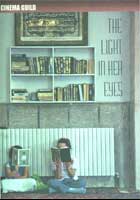
The Light in Her Eyes 2012
Distributed by Cinema Guild, 115 West 30th Street, Suite 800, New York, NY 10001; 212-685-6242
Produced by Julia Meltzer and Laura Nix
Directed by Julia Meltzer and Laura Nix
DVD , 87 min.
Sr. High - General Adult
Middle Eastern Studies, Religious Studies, Women’s Studies
Date Entered: 11/19/2012
ALA Notable: yes
Reviewed by Tracy Powell Iwaskow, Pitts Theology Library, Candler School of Theology, Emory University
What does the Qur’an teach about women’s roles in society? According to Houda al-Habash, a female Islamic preacher, it teaches that a woman must take care of her husband, children, and home first, but it also permits her to work outside the home, and receive a secular education. This is a somewhat progressive view in modern-day Syria, where many girls are still expected to marry in their late teens, and will not receive education beyond that.
The Light in Her Eyes follows Houda as she runs the Al-Zahra Mosque Qu’ran School, a women’s mosque in which hundreds of girls study Qu’ran intensively for two months each summer. Houda is matter-of-fact in correcting mispronunciations and too-lenient teachers, as well as when encouraging girls to take their memorization seriously. At one point she tells the entire school that younger girls can memorize the Qur’an more easily because they are more “pure in heart” without the distractions of television and pop music. School ceremonies celebrate taking the hijab and memorizing the entire Qur’an. Houda’s role as an advisor to other women is visible by way of scenes in which she provides advice to a divorcing woman and talks with teenage girls about the decision to wear hijab.
Interviews with several female journalists reveal discomfort by more secular Syrians in the face of Islamic revival. Houda responds to these concerns with respect but remains unyielding in her interpretation that Muslims must follow all of the Qur’an’s laws, while also separating those laws from rules imposed by more conservative male clerics. Conversations with Houda’s mother and 20-year-old daughter, Enas, demonstrate generational shifts within one family, although all three women share a view of education as a means of practicing Islamic piety. Interviews with a promising 13-year-old student show the challenges faced by the young Syrian girls Houda teaches, partly due to the temptations faced by many teenagers to enjoy the present day rather than prepare for the future, and partly due to cultural limitations—the girl’s declaration in one scene that she desires to attend college is juxtaposed with another later in the film in which her mother tells the camera that her daughter’s education will end with high school, because the family prefers for women to marry early. Houda believes that women’s religious education is key both to allowing women to live up to their full potential and to correcting misguided perceptions of Islam as a fundamentalist religion.
This film is suitable for discussions of religious studies and women’s roles by showing how women’s opportunities are developed within a cultural framework, and presenting a case in which a single text, the Qur’an, is used by various interpreters to support differing roles for women. Its focus on high school and college-aged girls and women can provoke reflection and discussion about educational opportunity and religious observance. It is appropriate for high school, college, and public library collections.
The technical quality of the film is high. Slightly tighter editing would be helpful, as some themes and shots (such as multiple street shots juxtaposing women in loose clothing and hijab with those in T-shirts and close-fitting pants) are repeated unnecessarily. It is also occasionally difficult to surmise what is happening at the beginning of a scene due to a lack of explanation via text or audio. The attentive viewer is able to follow a multilayered depiction of Muslim women’s roles in modern-day Syria.